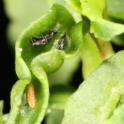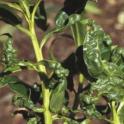Winter 2011: Regional Report: Biology and Control of the Myoporum Thrips
Regional Report San Diego and Riverside Counties
by James A. Bethke, David S. Shaw, Daphne Li, Marianne Whitehead, and Bryan Vander Mey
The myoporum thrips, Klambothrips myopori (Mound and Morris), is a very serious pest of Myoporum laetum in CA. It is well known by now as the myoporum thrips, but it really doesn’t have an official common name. The damage that it has been causing is quite significant and includes the death of shrub and tree forms of Myoporum spp. (fig. 1). There is almost nothing known about the pest, so we have been conducting various pesticide trials, and we have determined the life history at 30ºC.
Fig. 1. The myoporum thrips causes twisting and galling of new growth on shrub and tree forms of Myoprum laetum. (Click on thumbnail to view entire figure.) Photo by Jim Bethke
The average length of each life stage at 30ºC is the following: egg (13.90 ± 1.2 d), nymphal stages (13.87 ± 0.5 days), first pupa (5.27 ± 0.5), and second pupa (5.00 ± 0.4 days). In summary, the egg stage is about 13 days; nymph to adult is about 24 days. A generation from egg to an egg-producing adult is about 38 days. It was surprising to see the results about the different life stages and the length of time in each stage, but when we compared it to a closely related species, the Cuban laurel thrips Gynaikothrips ficorum (Marchal), they are almost identical.
This thrips is also similar to the Cuban laurel thrips in that they are rather host specific and cause new growth to twist and gall. The galling protects these thrips from insecticide contact and makes them a real challenge to control (fig. 2).
Fig. 2. The myoprum thrips are protected from contact with insecticides by the galling effects they cause on Myoporum spp. leaves. (Click on thumbnail to view entire figure.) Photo from UC IPM
In our trials against the myoporum thrips, products that are showing excellent to good control at the highest recommended rates are the following: Dinotefuran (drench, and trunk applications), Thiamethoxam (foliar and drench applications), Imidacloprid+Bifenthrin (combo product as a foliar), Bifenthrin (foliar) and Imidacloprid+Abamectin (combo product as a foliar).
The single application in our trial was effective for most products for 60 days. At our 60-day assessment, no thrips were observed in plants treated with a trunk application of Dinotefuran or a drench application of Thiamethoxam.
The systemic products are working surprisingly well as drench applications, probably because of the increased concentrations of the products in the plant compared to the foliar applications. In our research at UC Riverside with Dr. Frank Byrne, the foliar applications have been shown to be not as effective nor are they as persistent as the drench applications. In addition, this insect is difficult to contact with pesticides, so effective applications include protecting new growth or applying systemic products so that the toxicant can reach the feeding stages within the galled tissue.
James A. Bethke is Farm Advisor, David S. Shaw is Farm Advisor, Marianne Whitehead is Agricultural Technician, Daphne Li is Student Assistant and Bryan Vander Mey is Staff Research Associate, UC Cooperative Extension San Diego County.














